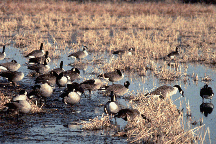| BIO326 : Population : Population Dynamics : Lesson | ||||
| BIO326 : Population : Population Dynamics : Lesson | ||||
 |
Glossary terms that are important in this lesson:
Density-dependence, density-independence, deterministic, emigration, exponential, fecundity, geometric, habitat fragmentation, immigration, intrinsic rate of increase, metapopulation, mortality, rate, regulation, steady-state, stochastic, territoriality |
Populations change in size and density, depending on birth rates and death rates. Environmental conditions affect life table values and population models predict future changes in population density.
I. Population Growth and Regulation
| Species | Conditions | Density-Dependence | Mechanism |
|---|---|---|---|
| Fruit flies | Fixed supply of food | Fecundity varied inversely with density of flies | Competition for food |
| Grain beetles Rhizopertha dominica | Fixed supply of food | Mortality killed all but one | Competition, territoriality? |
| Water fleas Daphnia pulex | Fixed supply of food | Mortality increased, fecundity decreased | Competition |
| Song sparrows | Population on island, density fluctuated from low to high naturally | Decreased fecundity of adults; increased mortality of juveniles | Territoriality limited breeding males; females competed for food in breeding season; competition for food between adults and juveniles |
| White-tailed deer | Range conditions varied | Fecundity varied directly with range conditions | Competition for quantity and quality of food |
| Flax Linum | Seed density varied | Decreased growth; increased mortality | Competition for resources |
| Horseweed Erigeron canadensis | High seed density | Increased mortality; growth rate of survivors increased | Competition for resources |
II. Temporal and Spatial Dynamics
When you have completed this lesson, go on to Review Questions
 Copyright 1999
Northern Arizona University
Copyright 1999
Northern Arizona University